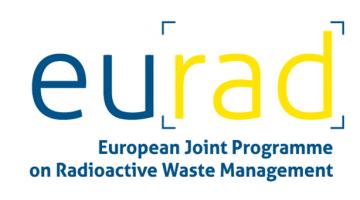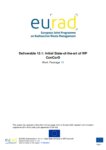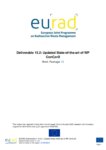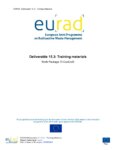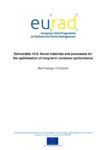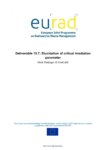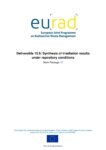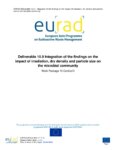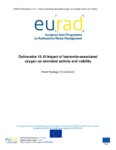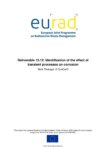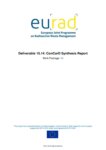CONCORD: CONtainer CORrosion under Disposal conditions (EURAD WP)
Project Dates: 1st June 2019 – 30 May 2024
Project Status: Finished
Project Website: https://www.ejp-eurad.eu/implementation/container-corrosion-under-disposal-conditions-concord
CONCORD was a R&D Work Package (WP) within EURAD. It aimed to further the understanding of container corrosion under disposal conditions.
Overview
The concept of a sealed container (or canister) for the disposal of high-level radioactive waste (HLW) and spent fuels (SF) is intended for use in applied in all deep geological repository programmes in nations that operate nuclear power plants. The container constitutes one of the main barriers in the overall multi-barrier disposal system which provides a complete confinement of radionuclides. Therefore, attention is frequently focused on the performance of the canister, especially concerning the length of time during which the material
stability and thus the barrier function can be guaranteed. This was the subject of the research carried out in ConCorD. The main body of the work conducted in ConCorD was divided into six main tasks, as follows:
• Task 1: Management and coordination.
• Task 2: Novel materials
• Task 3: Corrosion under irradiation
• Task 4: Microbial effects
• Task 5: Corrosion under transients
• Task 6: Modelling and integration into performance assessments.
Objective
WP ConCorD:
• Explored the potential of novel container materials and processes for optimisation of container performance within the engineered barrier system.
• Deepened the understanding of coupled interfacial processes influencing container performance under repository relevant conditions, with a focus on irradiation-accelerated corrosion, microbial activity and degradation during nearfield transients.
• Demonstrated the obtained mechanistic process understanding and develop predictive models leading to more focused performance assessments for addressing identified safety needs.
Task Outcomes
Task 1 encompassed the overall management and review of the project, including scientific-technical coordination and integration, and preparation of a State-of-the-Art report (SotA).
Task 2 – Novel materials
Task 2 of the ConCorD project aimed to explore the potential of novel materials and processes for the optimisation of long-term container performance for high-level waste disposal. The task focused on the experimental work on ceramic and metallic materials for bulk containers and coatings. The main achievements of the project include the development of new alumina-based materials for sealing bulk ceramic containers by microwave heating, the determination of the optimal parameters for sintering high-density silicon carbide, the comparison of the performance of different copper grades in simulated groundwater, and the production and testing of various ceramic and metallic coatings by cathodic arc evaporation and cold spray processes.
The task also outlined future research directions for the development of novel materials for containers. Ceramic materials have high corrosion resistance and low gas formation, but their mechanical strength and sealing processes need to be improved. Metallic materials can offer corrosion resistance depending on the alloy composition and the coating technology, but the overall understanding of their degradation mechanisms under repository conditions requires further work. Alumina-based ceramics can be sealed by microwave heating with specially designed sealing materials, and hetero-aggregation can be used to improve the microwave coupling of the sealing material via a nano-structuration process. SiC-based ceramics can be doped with Cr to increase their fracture toughness and corrosion resistance and can be joined by laser or glass-ceramic methods. CrN-based and TiO2-based coatings, whose properties can be tailored by varying the deposition parameters, can provide high corrosion protection for steel substrates. The participants in Task 2 were KIPT, IRCER, ANDRA, VTT and EMSE.
Task 3 – Corrosion under radiation
Task 3 focused on the effects of radiation on corrosion behaviour. The experiments were designed to represent the conditions expected in the repository with the inclusion of tests in representative bulk solutions and buffer materials at different saturation levels, groundwater compositions, temperatures, and redox conditions. The experiments were conducted using carbon steel and copper.
The results from tests conducted in bulk solutions (Jacobs) demonstrated that for copper, the presence of radiation results in an increase in corrosion rate measured under all dose rates investigated (0.1 to 10 Gy hr-1), with an increasing effect at higher dose rates. The increase in corrosion rate due to the presence of radiation varied from 0.03 to 1.15 µm yr-1, for dose rates from 0.1 to 10 Gy hr-1, respectively. However, due to the verylow corrosion rate of copper in the absence of radiation of 0.02 µm yr-1, the additional corrosion loss due to radiation, reflected a large relative increase compared to unirradiated conditions. For carbon steel, the influence of radiation on corrosion rate was less substantial than for copper. A significant increase in corrosion rate was only detected above 10 Gy hr-1. At 10 Gy hr-1 the presence of radiation led to an increase in corrosion rate by 0.90 and 1.41 µm yr-1, following exposure durations of 10,000 and 5,000 hours respectively. However, since the corrosion rate of carbon steel in the absence of radiation was between 1.57 and 3.51 µm yr-1, the increase in corrosion loss due to radiation was modest relative to the corrosion rate in unirradiated conditions.
It was found that at 150°C, the presence of radiation resulted in a significant inhibition of the corrosion rate for all durations tested and in both types of bentonite. A more modest inhibition was also observed for tests performed in BCV (Bentonite Cerny Vrch ) bentonite at 90°C, but in MX-80 bentonite the influence of radiation on corrosion rate was negligible. The work undertaken provided additional information on the potential influence of the type of bentonite used, the nature of the irradiation source (Co-60, Cs-137), the effect of water saturation (63%-100% relative humidity), and the dose rate (0.4-657 Gy hr-1).
Contrasting results were obtained about the effect of gamma-irradiation on steel corrosion, where the corrosion was enhanced in experiments conducted by SUBATECH and CIEMAT while the steel corrosion decreased under irradiation at high temperature (150°C) in experiments conducted by UJV. Experiments conducted under controlled water saturation at 25°C (SUBATECH) showed a strong effect of radiation, which enhanced steel corrosion compared to reference non-irradiated samples. Nevertheless, the lowest percentage of relative humidity (63% RH) showed the highest corrosion rate (as high as 250 µm yr-1), which then decreased with increasing water saturation (100%). In the case of experiments using carbon steel contacting compacted MX-80 bentonite at different saturation levels (60% and 100%) (CIEMAT), the corrosion rate of carbon steel was higher in the presence of gamma irradiation relative to reference samples and increased with increasing saturation from 60% to 100% (in contrast to experiments conducted by SUBATECH). Similar experiments by CIEMAT using copper showed only minor corrosion under irradiation. Experiments with steel and fully saturated MX-80 or BCV bentonite conducted by UJV showed lower corrosion rates under irradiation compared to reference experiments at 150°C, while gamma radiation had no significant effect on steel corrosion at lower temperatures (90°C and room temperature). The lower corrosion rate of carbon steel heated at 150°C and irradiated in the BCV bentonite was explained mainly by temperature and possibly lower saturation considerations. The effect of irradiation was minor due to low dose rates. Nevertheless, similarities were found for all experimental configurations such as the decrease of corrosion rate with increasing time or typical corrosion products such as siderite, magnetite or iron hydroxides. Furthermore, no clear impact of the dose rate or the type of irradiation (Co-60 vs Cs-137) on the steel corrosion was found. Finally, it is concluded that the radiation effect on steel corrosion should be investigated further to elucidate the mechanisms governing the corrosion process (corrosion rate and corrosion products) under the anticipated repository conditions. Among the subjects to be developed, the work highlighted the role of humid air radiolysis, in particular the yield of radiolysis products as a function of relative humidity, which impacts the corrosion kinetics. This could be achieved both experimentally and by modelling. Also, the combined effect of temperature and radiolysis on steel corrosion needs to be better understood.
Task 4 – Microbial effects
The work performed in WP ConCorD’s Subtasks 4.1 and 4.2 focused on the effect of irradiation and other repository-relevant stressors, such as heat and bentonite density, on indigenous microorganisms in bentonite, and their effect on the corrosion of canister materials. The results obtained demonstrated that the initially high temperature and gamma-radiation have the potential to exhaust most microbial activity in the bentonite zones subjected to temperatures of at least 90°C. As a consequence of the suppression of microbial activity in the buffer, biofilm formation on the canister surface does not need to be considered. However, further microbiological studies combined with mathematical modelling of temperature evolution in a DGR are necessary to predict the size and spatial distribution as well as the long-term persistence of such microbially depleted zones in the bentonite buffer around the metal canisters. When full saturation is reached, microbial activity will be further suppressed by compacted bentonite where the threshold dry density depends on the bentonite (their physical-chemical properties and the indigenous microbial communities). The current results indicate that the methodologies and experimental setups developed within ConCorD can be used as a standard method for investigating threshold densities for buffer candidates. It was shown by batch microcosm experiments that the Calcigel bentonite is a good candidate for studying the impact of dry density on microbial activity and corrosion because this bentonite has a low sulphate content and contains natural sulphatereducing bacteria that have the potential to contribute to corrosion.
It is expected that the only form of microbially influenced corrosion that needs to be considered is that due to the diffusion of aggressive metabolic by-products (invariably sulphide) to the canister surface from locations at which microbial activity is deemed to be possible. In accordance with this assumption, the compacted bentonite samples from UGR that were supplemented with SRB and IRB showed the highest alteration of the metal surface (at 1.6 g cm-3). This shows that introduced microorganisms can affect the corrosion even in bentonite compacted at a high dry density. The non-irradiated compacted bentonite samples without additional bacteria showed that the metal surface was covered with copper oxides and the coupons had a low corrosion rate (as studied in detail in Task 3). Results from UGR/CIEMAT also showed that the porewater used and the method of compaction (first saturated then compacted, or first compacted then saturated) can have an influence on the corrosion behaviour.
One of the objectives of this project was to enable cross-comparison between the results obtained, in order to optimise future research methods. This is important as it is known that DNA extraction plays a crucial role in determining the variability of results obtained through 16S rRNA amplicon sequencing. In particular, bentonite and other clay samples can impede the efficiency of standard cultivation-independent techniques. These samples often contain low biomass, further complicating the extraction process. To address these concerns, an inter-laboratory comparison study was conducted to thoroughly assess the efficacy of two published DNA extraction methods specifically designed for bentonite samples. Notably, our findings indicate that the selection of one or other method is not critical, but rather depends on the specific analysis requirements. However, it is crucial to maintain consistency in the chosen method, as comparing results becomes challenging, particularly in the presence of bentonite. Additionally, we discovered that slight modifications to one of the extraction methods can enhance its efficiency. In summary, the study emphasises the importance of standardised DNA extraction methods and underscores the importance of validating these methods using appropriate controls when studying microbial communities with 16S rRNA amplicon sequencing, particularly in environments characterized by low biomass and clay-rich compositions.
Task 5 – Corrosion under transients
Task 5 aimed to identify the role of transient conditions on the corrosion of materials selected for disposal canisters in deep geological repositories for high-level radioactive waste. Experimental work was carried out by four separate organisations, namely CIEMAT, GRS, KIT-INE and UJV-SURAO.
CIEMAT analysed the impact of redox, hydraulic and thermal near-field transients on the corrosion and bentonite interactions, simulating the canister / bentonite interface of a deep geological repository. Both laboratory scale and in situ experiments, carried out at the Äspö Underground laboratory (Sweden), were analysed. The samples from the Äspö-ABM5 in situ experiment were hydrated for 4.4 years with Äspö granitic groundwater at temperatures up to 250°C. Thus, these samples were representative of coupled hydration, temperature, redox and chemical transients. Analyses of different bentonite samples revealed that all bentonites analysed preserved their hydro-geochemical properties after being subjected to saline groundwater infiltration, heating and interaction with corroding metals for 4.4 years. The main changes observed in all the bentonite samples were the modification of exchangeable cation composition and an increase in the iron in the bentonite as a function of the distance to the contact point with the heater, due to corrosion of the heater.The main corrosion products were goethite, haematite and siderite.
CIEMAT laboratory experiments were representative of coupled thermo-hydraulic gradients and thermohydraulic-chemical interactions. CIEMAT’s activities covered a range of transient conditions affecting corrosion of metals, such as resaturation of compacted bentonite, convective water vapour saturation fluxes, ambient and high temperature (80°C), different salinity of the infiltrating waters and variations in oxic/anoxic conditions. The corrosion rates measured for all carbon steel coupons in contact with the bentonite, hydrated with different waters and subjected to 80°C, ranged between 28 µm yr-1 and 413 µm yr-1, with the highest corrosion rate observed for the Nagra carbon steel coupon tested with FEBEX bentonite compacted at 1.4 g cm-3. The corrosion rates of Cu-OFP coupons subjected to the same conditions were significantly lower, ranging from 3 to 9 µm yr-1.
GRS analysed the effects of the consumption of oxygen enclosed in saturated bentonite on the first stages of corrosion. Electrochemical techniques, such as polarisation curves (current-voltage curves) and electrochemical impedance, were used to monitor the evolution of the corrosion rate for a period of about 3 months. The electrochemical experiments were performed in a dedicated cell containing the oversaturated Wyoming bentonite slurry (Na-bentonite like the MX-80) prepared with artificial Opalinus Clay water with a ratio of 1:10 w/w. The experiments were complemented using surface analysis techniques, including SEM-EDX and localised XPS to identify the nature of the corrosion products formed. Electrochemical experiments in Opalinus Clay water with different oxygen contents at different temperatures were performed in order to obtain additional information on the corrosion kinetics. The middle-term runs were performed at temperatures of 30°C and 50°C. A miniaturised Pt-sensor was tested to follow pH-changes in close proximity to the corroding surfaces by running cyclic voltammetry measurements from time to time. Comparative experiments were carried out under gamma-irradiation conditions.
The corrosion rates measured by GRS for GGG40 cast iron in contact with a slurry of bentonite hydrated with synthetic Opalinus clay were 6 µm yr-1 and 13 µm yr-1 for 30°C and 50°C, respectively. The electrochemical investigations showed that at the corrosion potential, oxygen reduction was mass-transport controlled, the diffusion of oxygen being restrained by the slurry, indicating that kinetically controlled water reduction seemed to predominate. A gamma-radiation dose 130 Gy hr-1 on GGG40 in the same bentonite slurry at 50°C increased the mean corrosion rate to 52 µm yr-1.
KIT-INE performed corrosion experiments with spheroidal graphite cast iron (SGI) and cupronickel alloy (CuNi) in contact with a bentonite slurry hydrated with granitic groundwater. Ex situ experiments were carried out in the laboratory under anoxic conditions in a N2- or Ar-filled glovebox, under static and dynamic conditions, and for contact times lasting up to 12 months. The purpose of these experiments was to provide information about the effect of porewater renewal on the investigated processes and performed experiments in closed vessels at 25°C and at 50°C. Experiments under dynamic conditions were carried out using cylindrical vessels and the flow rate was applied by using a peristaltic pump. The applied transient conditions were specific for each selected material. In the case of spheroidal graphite cast iron (SGI), a layer of a ferric compound was inserted between the metallic coupon and the bentonite. In experiments involving cupronickel coupons, the porewater was spiked with sulphide once corrosion processes had already started. Reference experiments were performed separately in the absence of ferric compounds or added sulphide, in order to identify the effect of these parameters on the corrosion behaviour of the metallic materials.
The KIT results showed that SGI corroded upon exposure to the bentonite suspension hydrated with low saline granitic water, where the redox potential decreased in all experiments, suggesting the formation of Fe(II)-bearing secondary phases. Comparative experiments performed in the presence of haematite did not significantly alter the steel degradation mechanism. After 3 months at 25°C in contact with the bentonite suspension, the corrosion rate was 4.8 µm yr-1, favoured by the larger amount of water available. Increasing the temperature to 50°C significantly increased the corrosion rate to 10.6 µm yr-1. Corrosion rates decreased systematically with increasing reaction time. In comparison, CuNi corrosion was significantly lower, with the highest value being 2.7 µm yr-1 at 50°C. The presence of added sulphide had no significant effect on corrosion but may have had an effect at longer exposure times, or higher sulphide concentrations.
UJV-SURAO studied the effect of increased temperature and gamma-irradiation on the acceleration of corrosion of carbon steel in compacted Ca-Mg bentonite, including MX-80 in a limited number of tests, to gain an insight into the chemical evolution and its influence on the development of the carbon steel canister / bentonite interface. Results showed that the carbon steel samples heated at 150°C in the BCV bentonite had lower corrosion rates when irradiated compared to unirradiated samples, ranging from around 2 µm yr-1 to 24.3 µm yr-1 at 150°C with irradiation. Unirradiated samples heated to 150°C showed the highest corrosion rate after 6 months but they decreased when the loading period was prolonged to 18 months. A decreasing corrosion rate was observed in both irradiated and unirradiated steel samples heated at 90°C with increasing exposure period.
Task 6 – modelling
Three modelling tasks were undertaken to cover (i) reactive transport modelling of the corrosion behaviour of steel in bentonite, (ii) the inclusion of microbial activity in geochemical models of repository behaviour, and (iii) repository scale modelling of sulphide in a repository. The report describes how the models were set up and provides some preliminary results from the modelling activities. Sub-task 6.1 focused on creating a numerical tool that can take account of modelling water and chloride radiolysis and their consequent effect on corrosion behaviour based on their effect on electrochemical processes. The results of the modelling were compared to experimental results from a radiation-corrosion experiment for steel in bentonite.
Sub-task 6.2 outlines a mathematical description of microbial activity based on treating microbes as colloidlike chemically reactive particles. Some examples of applying the model to a common sulphate-reducing bacteria system are given.
Sub-task 6.3 involved development of a previous 1D model for the sulphide evolution in the near-field and sulphide corrosion on copper canisters in the Swiss DGR to create a 2D model. It was also extended to estimate sulphide corrosion on both copper and steel canisters under different repository settings, including the effect of badly-emplaced” buffer and high pH plumes from a concrete liner. The model was used to predict the corrosion depth after 1 Myr for copper and steel canisters in various scenarios.
For each task, as a section is included which reflects on the significance of the results obtained and how they might be applied to future performance assessments. The report concludes with an overview of the significance of the results from the various tasks and their relevance to the preparation of future performance assessments.

